
After Italy entered World War II on 10 June 1940, mail could no longer be flown between Alexandria (Egypt) and the UK via the Mediterranean and the Horseshoe Route was set up with the first flights being on 19 June [2].
The New Zealand Post Office was very late in accepting mail for the Horseshoe Route and the first official dispatch was not until 22 July connecting with WS 6 which left Sydney on 24 July and arrived in Durban on 6 August [19].
Covers to and from Middle East Forces are shown here.
Horseshoe Route covers from New Zealand
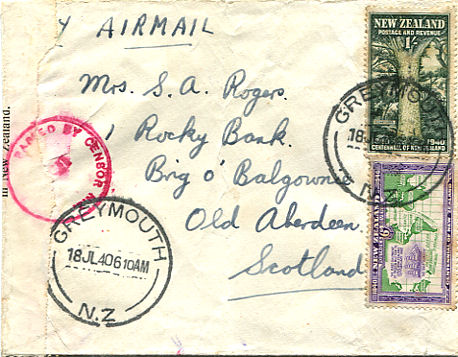
First Dispatch from New Zealand to UK, July 1940
This cover is postmarked at 6.40 am on 18 July in Greymouth which is on the west coast of the South Island. It would be carried on the Greymouth - Christchurch express train to Christchurch where it was opened and passed by the censors.
The trans-Tasman airmail closed in Christchurch at midnight on a Friday (i.e. 19 July) and so there was sufficient time for the cover to arrive in Auckland to be flown on the first acceptance on 22 July.
Flight WS 6 left Sydney on 24 July and arrived in Durban on 6 August.
There was a poor connection at Durban and the Windsor Castle
did not arrive in the Clyde until 1 September.
Walker reports that the mail was delivered on 5 September [1].

New Zealand to UK, August 1940
This registered cover was posted in Akaroa on 11 August 1940 and has no censor markings. Despite being registered, it has no backstamps. It is franked with 1s 10d which covers 1s 6d postage plus 4d registration fee.
It would be flown from Auckland to Sydney on the Aotearoa on 15 August and then on XWS9 on Saturday 17 August) which arrived in Durban on 1 September [4]. From this date, the Horseshoe service was twice-weekly and left Sydney on a Saturday as well as a Wednesday.
The mail was then sent by sea to GB on the Arundel Castle which left Cape Town on 11 September and arrived in the Clyde on 28 September [20].
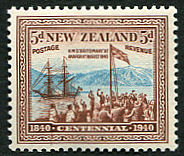
The cover commemorates the centenary of the raising of the British flag in Akaroa on 11 August 1840 by the crew of HMS Britomart to assert British Sovereignity over the South Island. This is also celebrated on the 5d value of the Centennial Issue.
The reason for the action was the imminent arrival of French settlers and Akaroa (which is near Christchurch) is the only New Zealand town that was founded by the French.
The first nine Horseshoe mails left Sydney on a Wednesday, but
from Saturday 17 August they were twice a week
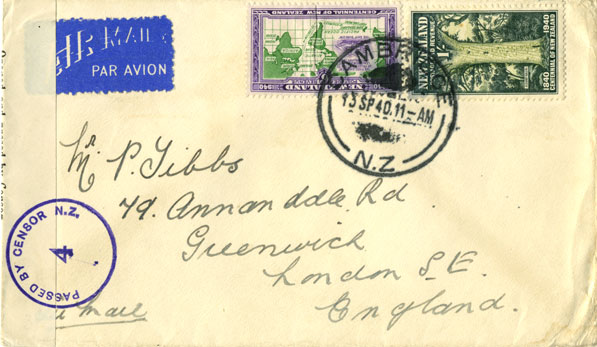
New Zealand to UK, September 1940
The next cover is postmarked in Cambridge which is in the North Island on 13 September, 1940 and is addressed to England. It was opened and passed by the censor in Auckland. It would have been flown trans-Tasman on 18 September.
This cover would have been flown to Durban on WS 19 which left Sydney on 21 September and arrived in Durban on 4 October and then carried to UK by sea on the Roslin Castle from 9 - 28 October [16].
From 27 September, the Horseshoe flights left Sydney on Friday and Tuesday rather
than Saturday and Wednesday.
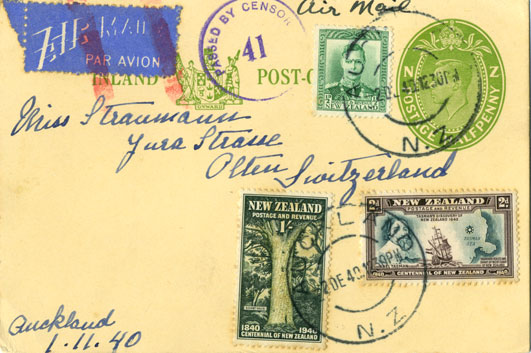
New Zealand to Switzerland, December 1940
The next is a postcard to Switzerland postmarked on 2 December 1940 in Auckland where the Passed by Censor mark was added. It would have been flown to Sydney on 5 December and then on WS 41 that left Sydney on 6 December and arrived in Durban on 19 December and from there to the UK by sea. This mail is known delivered in London on 11 February 1941.
The airmail etiquette was cancelled in London with two parallel red lines to indicate that the airmail part of the journey was over. From the UK it would have been sent to Lisbon by sea and from there by surface through Spain and Vichy France to Switzerland.
It has a franking of 1s 3d.
The airmail postcard rate was half the airmail rate.
The airmail rate to Switzerland had been increased
from 2s to 2s 6d when the trans-Tasman
airmail service was introduced on 30 April.
It was reduced back to 2s on 5 March 1941 [9].
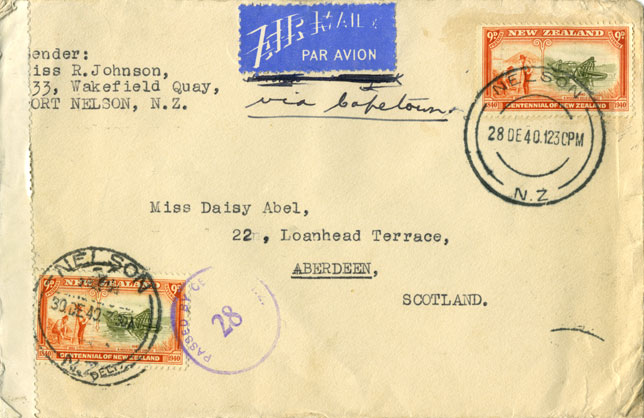
New Zealand to UK, December 1940
One stamp on this cover is postmarked in Nelson on 28 December 1940 while the one at the bottom left is postmarked there on 30 December. It is inscribed via Capetown in manuscript. Likely flown trans-Tasman on 4 January and then on WS 50 from 7 - 21 January, but it is not clear when this mail arrived in the UK.
It was opened and passed by the censor in Wellington (censor number 28) as the
Nelson censor office did not open until April 1941 [9].
Redirected Mail
Because of wartime conditions, mail was often delayed en route and so took significantly longer than the officially quoted times. Transit marks, even on registered items, are far less common than they were pre-war for security reasons. Redirected mail is therefore especially important in determining transit times as they were normally postmarked again after they had been redirected. It is always possible that they were not redirected immediately and so times calculated are upper limits.
With the Horseshow Service, there were sometimes problems with the connection between the Horseshoe airmail route and the weekly sailings between South Africa and the UK together with general problems of capacity.
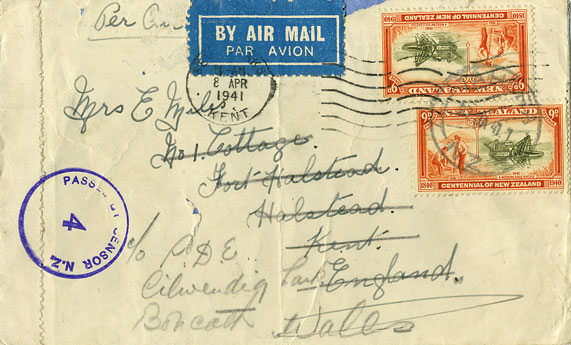
New Zealand to UK, 31 January 1941
This cover is postmarked on 31 January 1941 and was opened and passed by the censor in Auckland. It was redirected to Wales on 8 April. This was 67 days after being posted in New Zealand.
It would have been flown trans - Tasman on 3 February and then from Sydney on 4 February on WS 58 and arrive in Durban on 17 February.
That mail was sent from Cape Town on the Rochester Castle which left Cape Town
on 23 February and arrived in the UK on 27th March.
According to contemporary Singapore newspapers, that mail was delivered in London on 2nd April
and so there is a significant delay before it was redirected in Kent.
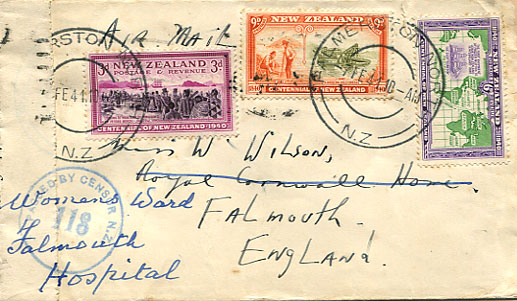
New Zealand to UK, 7 February 1941, 60 days transit

This cover was postmarked in Palmerston North one week later on 7 February 1941 and was opened and passed by the censor in Wellington. It would have been flown trans-Tasman on 13 February and then on WS 61 on 14 - 27 February.
It was redirected in Falmouth on 8 April after arrival in England which is the same date as the previous cover. This was 60 days after being posted in New Zealand.
At that time ships from South Africa would often join a convoy at Sierra Leone which greatly increased the transit time. It was often around 20 days between a ship leaving Capetown and the convoy leaving Sierra Leone and then around a further 20 days for the convoy to reach UK. Convoy SL 68 left Sierra Leone on 12 March and arrived in the Clyde on 3 April with the mail delivered in London on 5 April. The ship that carried this mail was the Clan Chatton and the dates tie in with the redirection in Falmouth on 8 April.
The censor handstamp is in blue rather than the usual purple.
It seems that the known examples all have Palmerston North postmarks [17].
Problems due to Rebellion in Iraq: April - July 1941
A rebellion in Iraq, supported by the Nazis, started in late April 1941 and was followed by fighting in Syria. This disrupted the Horseshoe Route in both directions for several months [21].
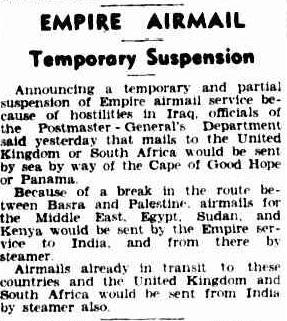
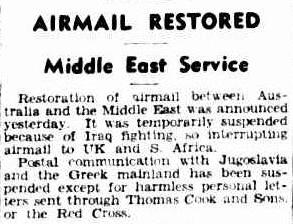
The service between Cairo and Basra was suspended in early May as Lake Habbaniya was inaccessible although the UK continued to send mail to South Africa with the view that it was only a temporary suspension [14].
The Horseshoe Route service from Australia was suspended in early May 1941 and that would, of course, affect the service from New Zealand. The suspension was announced by the Australian Post Office on 6 May while the restoration was announced on 14 May. The announcements on 7 and 15 May 1941 in the Melbourne newspaper The Argus are shown [13].

According to the Civil Aviation Intelligence Summary (CAIS 101) of 21 May, a non-stop service between Tiberius and either Kuwait or Basra was started on 18 May and the service between Basra and Singapore was now once a week [15]. The map shows the different routes that were used between Cairo and Basra [21]. Kuwait does not appear to have actually been used.
Because of the reduction in capacity on the Horseshoe Route some of the airmail from the UK for Australia and New Zealand was sent by air to USA via Lisbon for surface transit across the Pacific on 22 and 25 May and on 1 June [14].
According to CAIS 106 of 25 June, due to the fighting in
Syria, Tiberius had been replaced and the route was now Cairo - Aqaba - Lake Habbaniya
- Basra [15].
The Karachi - Singapore service was once a week, but KLM were
operating a extra weekly service between Batavia and Lydda
and, from late May KLM, had been awarded a contract to
carry Troop Mail between the Middle East and Singapore.

New Zealand to UK, June 1941, Air Service Suspended cachet
This cover is postmarked in Wairoa (between Napier and Gisborne) on 20 June 1941, was opened by the censor in Wellington (censor number 27) and resealed with censor tape with the single line inscription given twice that replaced the two line inscription in April 1941 [9].
It has an unusual Air Service Suspended cachet that I have not seen before and it is not clear where and why it was applied although it could have been due to the fighting in Iraq and Syria.
The cover may have been flown on WS 98 that left Sydney on 24 June.
That service did not proceed beyond Singapore (arrival 27 June) with the mail
being transferred to WS 99 which left Singapore on 1 July.
It flew from Basra to Cairo via Aquaba on 5 July and and arrived in Durban
on 10 July [4].
The cachet could therefore have been applied in Singapore when service
WS98 was suspended and the mail had to wait for the next flight.
As quite a few services at that time did not proceed beyond Singapore,
the cachet should not be that uncommon, but I can find no reference to it in
the literature.
New Zealand to UK, July 1941, 88 days transit
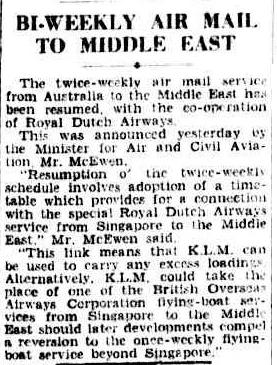
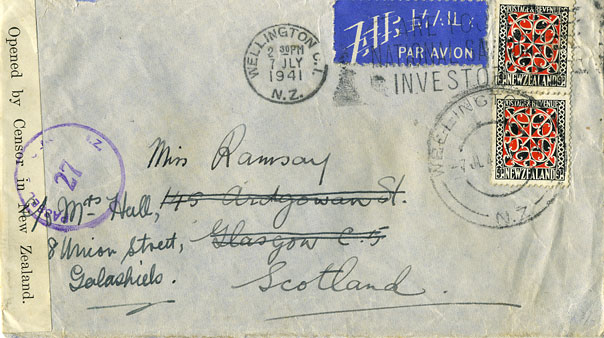
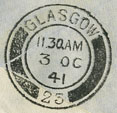
This redirected cover is postmarked on 7 July in Wellington where it was passed by the censor. It was redirected after arrival in Glasgow on 3 October, 88 days later. May have been flown trans - Tasman on 10 July and then on WS 103 that left Sydney on 11 July and arrived in Durban on 24 July. According to [16], the next ship left South Africa on 1 August, but did not arrive in UK until 1 October. That fits with the redirection date.
A reduced service on the Horseshoe Route remained during June and the
first half of July with
the resumption of a twice weekly service being announced in Australia on 18 July.
The newspaper announcement on 19 July 1941 in the Sydney Morning Herald is
shown [13].
According to CAIS 110 of 23 July 1941, the twice weekly service
was resumed on 17 July [15].
Twice Weekly Service Restored
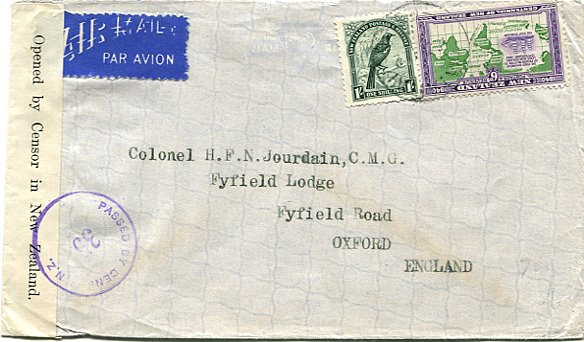
New Zealand to UK, July 1941, 62 days transit
The postmark on this cover is faint, but appears to be 15 July 1941 and so the twice weekly service from Singapore had been reinstated by the time it reached there.
It was censored in Wellington and has Rd 15 Sep 1941 in manuscript on the back
and so it took 62 days.
Likely flown trans-Tasman on 19 July and on WS 106 that left Sydney on 21 July and arrived in Durban on 3 August.
According to [16], a mailship left South Africa on 12 August and arrived in the UK on 13th September which date fits with the manuscript date.
It therefore arrived before the previous cover due to the difference in the transit
times by sea from South Africa to the UK.
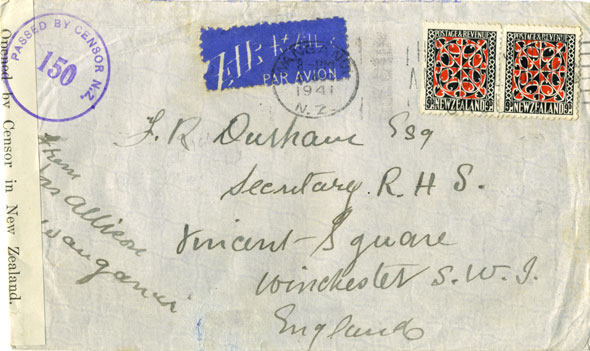
New Zealand to UK, August 1941
This cover is postmarked in Wanganui on 6 August 1941 and was opened there by the censor. (That is earlier than the earliest time shown in [9] for censor number 150.)
Before April 1941, there were only four censor offices in Auckland, Christchurch, Dunedin and Wellington. After that, there were also offices in Hamilton, Invercargill, Napier, Nelson, New Plymouth, Palmerston North and Wanganui [9].
The censor labels had been changed in April 1941.
Instead of Opened and Passed by Censor in New Zealand
on two lines,
the message was changed to Opened by Censor in New Zealand
on a single line and was now shown twice [5].
Horseshoe Route covers to New Zealand
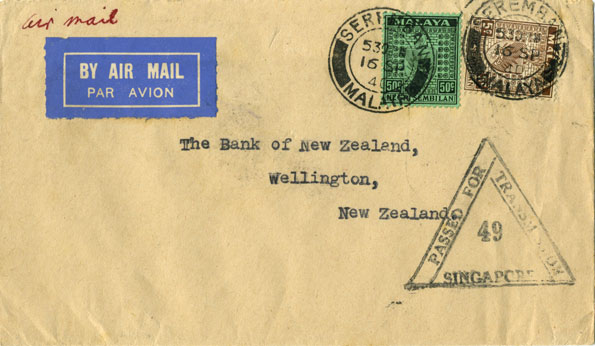
New Zealand from Malaya
The next two covers were flown on part of the Horseshoe Route that was, in fact, the same as the pre-war route.
The first cover is postmarked on 16 September 1940 in Seremhan in Negri Sembalin, Malaya and was sent from there to New Zealand. It is franked with 55c in stamps and has a Passed for Transmission Singapore handstamp in black.
It would be flown from Singapore to Sydney by Qantas
leaving Singapore either on NE 15 on 18 September or
on NE 16 on 21 September arriving in Sydney
on either 21 or 24 September.
With either arrival date in Sydney it would have then been
flown from Sydney to Auckland by TEAL on SA 25 on 27 September.
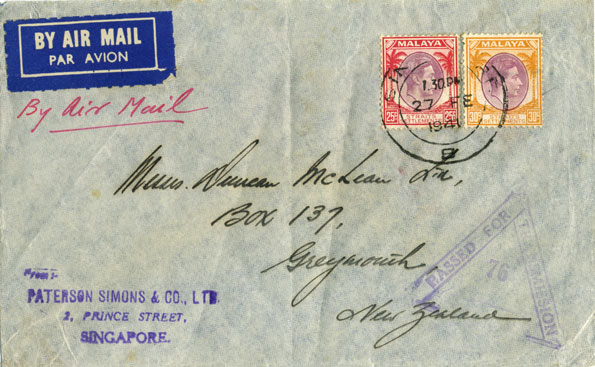
The next cover is postmarked in Singapore on 27 February 1941 and is franked with 55c in Straits Settlements stamps.
The Passed for Transmission handstamp is in purple.
The cover is likely to have been flown from Singapore on NE62 that left Singapore on 28 February and arrived in Sydney on 3 March or on NE63 that left Singapore on 3 March and arrived in Sydney on 6 March. There were trans-Tasman flights to New Zealand by TEAL on 6 March and on 9 March, but unfortunately there is no backstamp.
They are both ordinary commercial covers.
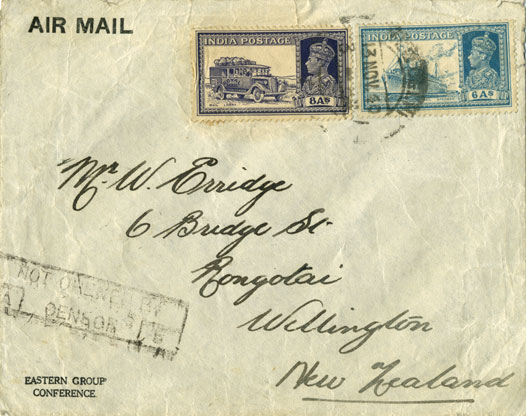
New Zealand from India
The Eastern Group Conference started on 25 October 1940 in Delhi and was attended by the governments of the countries in the eastern part of the British Empire to discuss war supplies. This cover was sent by a member of the New Zealand delegation in November 1940.
Being sent by a government official presumably explains why it has a
Not opened by censor handstamp.
It is postmarked on 13 November and so may have
been flown on NE33 that left Durban on 9 November, Karachi on
16 November and arrived in Sydney on 22 November.
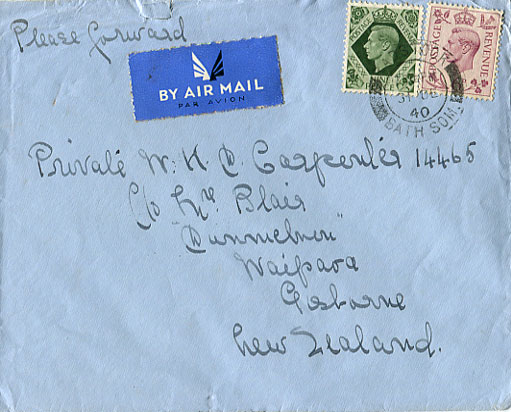
UK to New Zealand, December 1940, 70 days transit
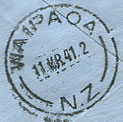 This cover is postmarked in Bath on New Year's Eve 1940 and is backstamped in
Waipaoa (near Gisborne), 70 days later on 11 March 1941.
It is franked with 1s 3d, the Horseshoe rate from UK to
Australia and New Zealand, and
has no censor markings.
This cover is postmarked in Bath on New Year's Eve 1940 and is backstamped in
Waipaoa (near Gisborne), 70 days later on 11 March 1941.
It is franked with 1s 3d, the Horseshoe rate from UK to
Australia and New Zealand, and
has no censor markings.
According to [14], there were dispatches from London on the Horseshoe Route on 2 and 6 January and Proud [16] lists both these dispatches as leaving the UK on 9 January and arriving in South Africa on 7 February.
The total weight of Horseshoe mail arriving in South Africa from the UK between 7 and 11 February was 7846 lb [14, 16] and so it would have taken four flights to clear it (NE 60 - NE 63).
As this cover was backstamped on 11 March that suggests that it
was flown on the trans-Tasman flight from Sydney to Auckland on 9 March.
That would have connected with NE 63 that left Durban on
22 February and arrived in Sydney on 6 March.
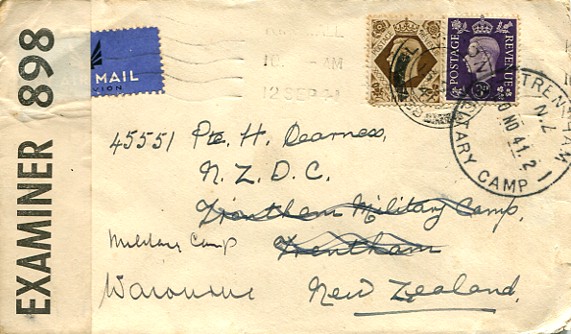
UK to New Zealand, September 1941, 69 days transit
Cover postmarked in Kirkwall in Scotland on 12 September 1941 and redirected at a military camp near Wellington in New Zealand on 20th November. The London dispatch of 17 September was sent on the Clan Farquar and connected in Durban on 5 November with NE 136 which arrived in Sydney on 17 November.
A trans Tasman flight was scheduled for 18 November which fits with the redirection date of 20 November.
Official Mail flown across Africa
In October 1940, a regular flying boat service was established between the UK and Lagos, Nigeria via Lisbon, Bathurst in Gambia and Freetown in Sierra Leone. From Lagos there was a link with the Horseshoe Route at Khartoum via Kano and Fort Lamy [2]. My understanding is that the capacity was limited and the route was only used for high priority official mail.
Warn shows a cover franked with official stamps from Wellington to
the High Commisioner's Office in London [11].
It is postmarked on 13 August 1941 and the postage rate is 4s 6d.
It has the routing instructions: Via Khartoum, Lagos, Bathurst
and West Africa Fying Boat.
The Reserve Routes, December 1941 - February 1942
The Reserve Routes and the end of the Horseshoe Route to Australia / New Zealand
are described here.
All scans were made by the author.
[1] Airmails of New Zealand, volume 2, D.A
Walker, 1986,
Air Mail Society of New Zealand
[2] The Horseshoe Route, Chavril Press, 1992.
[3] Airmails of New Zealand, volume 3, R.M.
Startup, 1997,
Air Mail Society of New Zealand
[4] Bridging the Continents in Wartime: Important Airmail Routes 1939-45,
H. E. Aitink and E. Hovenkamp, SLTW, Enschede, 2005.
[5] Civilian Postal Censorship in World War II Some Facts and Problems,
G. Branam, The Kiwi, vol 43, pp 90-97, September 1994.
[6] Further Wartime Interruptions to Air Mail Routes,
Bill Legg, Air Mail News, vol 47, pp 188 - 192, November 2004.
[9] The Postal History of World War II Mail between New
Zealand and Switzerland, R.M. Startup and C.J. LaBlonde, 2005.
[11] Some Problem Air Mail Postage Rates, I. Warn,
The Kiwi, vol 28, pp 126-128, November 1979.
[12] New Zealand Mail via the Indian Ocean Route during World War 2,
R.M.Lee, The Mail Coach, vol 26 no 1, pp 11-16, October 1989.
[13] Australian Newspapers 1803-1954,
Trove, National Library of Australia
[14] Overseas Mails Branch Weekly Reports Nos. 69-120, 1941, POST 56/77,
Royal Mail Archive.
[15] Extracts from the Air Ministry Civil Aviation Intelligence
Reports Summaries, compiled by P Wingent, West Africa Study Circle, 2010.
[16] Intercontinental Airmails Vol 2 - Asia and Australasia, E.B. Proud, Proud Publications 2009.
[17] Civilian Postal Censorship in New Zealand in World War II, R. Stone.
[18] Evening Post Wellington 1916-1945, Papers Past,
available at: paperspast.natlib.govt.nz/cgi-bin/paperspast
The Mail Coach, vol. 25, no. 1, pp 3-7, October 1988.
[19] Further Aspects of the Horseshoe Route: a New Zealand Perspective, R. Clark,
Air Mail News, vol 53, no 211, pp 179-184, November 2010.
[20] Convoy Web, available at: www.convoyweb.org.uk
[21] Disruption of Horseshoe Mail from Durban in mid 1941, R. Clark and P. Wingent,
Air Mail News, Vol. 55, no 220, pp 11-18, February 2013.